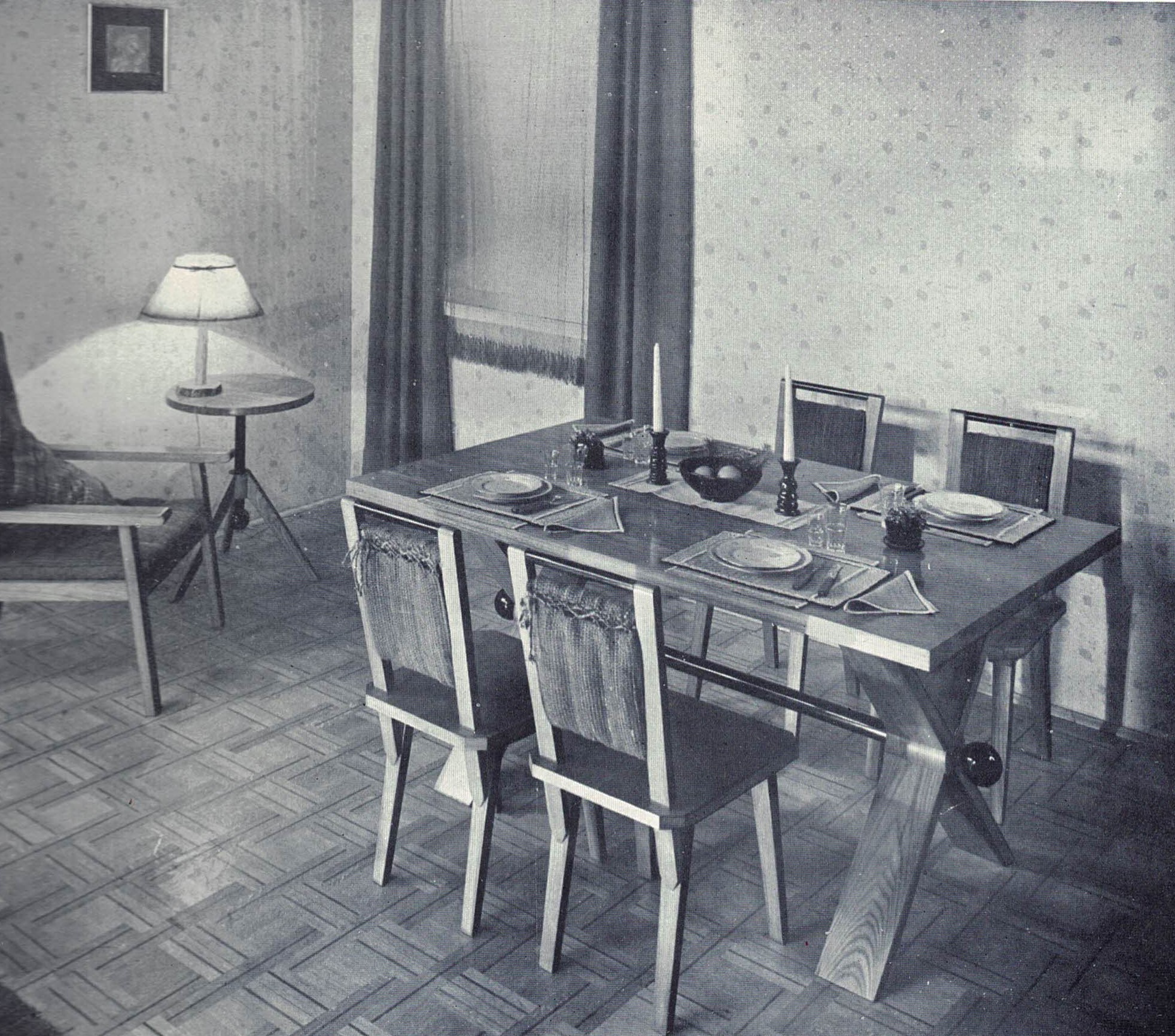Polskie międzywojenne poradnictwo w zakresie wnętrz mieszkalnych jako obszar relacji niemiecko‑polskich
Słowa kluczowe:
architektura wnętrz, poradnictwo w zakresie wzornictwa, zamieszkiwanie, okres międzywonenny, relacje polsko-niemieckieAbstrakt
During the interwar period, Polish interior design consulting stimulated our national achievements; however, it did not happen in isolation from foreign trends. One of the most distinct influences were the accomplishments of German residential culture. The previous German influence had been coloured by negative associations: with the period under German occupation on the one hand, and with the outdated apartment functions and aesthetics based on the residential culture of the late 19th century and its neo-style furnishings on the other. Yet as early as in the late 1920s, a completely different German horizon began to appear, gaining popularity in the 1930s. Ever since then German interior design and furnishing achievements became synonymous with rationality, functionality, and even, broadly speaking, general modernity. It is therefore difficult to present an unambiguous diagnosis of the German-Polish relationship relating to habitation during the interwar period. On the one hand it was difficult to escape the tensions generated by political and national prejudices, and on the other, to evade the neighbouring German cultural achievements and their real and positive impact on many Polish accomplishments, especially in the realms of architecture and habitation. One may say that the emotional antagonism which could be seen during the 1920s faded with time and was displaced, at least among experts, by an awareness of the nearby existence of successful models which, thanks to specialist literature and books, along with visiting fairs and exhibitions, were well known and appreciated.
Downloads
Bibliografia
Bilewicz Hubert, Meble w Zameczku prezydenta Ignacego Mościckiego w Wiśle. Kwestia chronologii, inwentarza i atrybucji, „Porta Aurea” 2009, nr 7–8, s. 284–345.
Błachowski Aleksander, Ludowe dywany dwuosnowowe w Polsce, Toruń 1990.
Chojecka Ewa S., Pomiędzy historią a nowoczesnością. Treści ideowe Zamku Prezydenta RP w Wiśle [w:] Zamek Prezydenta Rzeczypospolitej w Wiśle / The Castle of the President of The Republic of Poland in Wisła, red. Jacek Purchla, Kraków 2005, s. 11–20.
Chrzanowski Zenon, Kultura mieszkalna, Warszawa 1911.
Das schöne Heim. Deutsche Wohnvorstellungen zwischen 1900 und 1940 in Bild und Text, Hg. Andreas K. Vetter, Heidelberg 1999.
Dzisiejsze mieszkanie. Katalog pokazu. Miejskie Muzeum Przemysłu Artystycznego, Lwów, kwiecień–maj 1930, oprac. Henryk Cieśla, Lwów 1930.
Gładkowska Ewa, Ostpreussiche Bauernteppiche – Die Geschichte einer Polemik über Ihre Herkunft [w:] Die Etablierung und Entwicklung des Faches Kunstgeschichte in Deutschland, Polen und Mitteleuropa (anlässlich des 125-jährigen Gründungsjubiläums des ersten Lehrstuhls für Kunstgeschichte in Polen), Hg. Wojciech Bałus, Joanna Wolańska, Birte Pusback, Warszawa 2010, s. 557–569.
Hahm Konrad, Ostpreußische Bauernteppiche, Jena–Berlin 1937.
Hirth Georg, Das deutsche Zimmer der Renaissance. Anregungen zu häuslichen Kunstpflege, München 1882.
Hirth Georg, Das deutsche Zimmer der Gotik und Renaissance, des Barock-, Rococo-, und Zopfstils Anregungen zu häuslichen Kunstpflege, Leipzig 1899.
Huml Irena, Warsztaty krakowskie, Wrocław–Warszawa–Kraków 1973.
Huml Irena, Polska sztuka dekoracyjna XX wieku, Warszawa 1978.
Huml Irena, Ład w Katowicach [w:] Polskie art déco, red. Zbigniew Chlewiński, Płock 2015, s. 26–41.
Jurga Halina, Kilimy, gobeliny, dywany [w:] Spółdzielnia Artystów „Ład” 1926–1996, t. 1, red. Anna Frąckiewicz, Warszawa 1998, s. 154–179.
Karolczak Waldemar, Poznańskie magazyny mebli i ich oferta na przełomie XIX/XX wieku, „Kronika Miasta Poznania” 1999, nr 4, s. 76–92.
Kilimy polskie od XVIII do XX wieku, red. Maria T. Michałowska-Barłóg, Poznań 2008.
Kircher Ursula, Von Hand gewebt. Eine Entwicklungsgeschichte der Handweberei im 20. Jahrhundert, Marburg 1986.
Kizik Edmund, Verein für kaschubische Volkskunde w latach 1907–1914. Ludoznawstwo kaszubskie między niemieckością a polskością, „Zapiski Historyczne” 2015, z. 2, s. 31–54.
Kizik Edmund, Współpraca Izydora Gulgowskiego z gdańskim Kunstverein w roku 1909. U źródeł ceramiki nowokaszubskiej, „Kwartalnik Historii Kultury Materialnej” 2015, z. 3, s. 495–510.
Klekot Ewa, „Ład” i lud. Twórcy sztuki ludowej a twórcy „Ładu” [w:] Spółdzielnia Artystów „Ład”, t. 2, red. Anna Frąckiewicz, Narodowe Centrum Kultury [w druku].
Kluczwajd Katarzyna, Spojrzenie na Rzut. O wyposażeniu domu i wzornictwie w toruńskim wydaniu, Toruń 2002, s. 15–16.
Korduba Piotr, Danziger Möbel und Innenräume im 19. und 20. Jahrhundert und ihre polnischen und deutschen Konnotationen [w:] Visuelle Erinnerungskulturen und Geschichtskonstruktionen in Deutschland und Polen 1800 bis 1939, Hg. Robert Born, Adam S. Labuda, Beate Störtkuhl, Warszawa 2006, s. 305–321.
Korduba Piotr, Ludowość na sprzedaż. Towarzystwo Popierania Przemysłu Ludowego, Cepelia, Instytut Wzornictwa Przemysłowego, Warszawa 2013.
Korduba Piotr, Wnętrza gdańskie poza Gdańskiem [w:] Gust gdański, red. Bronisława Dejna, Jakub Szczepański, Gdańsk 2004, s. 150–164.
Korduba Piotr, Wystawa tkanin „Polska sztuka tkacka” w Instytucie Propagandy Sztuki w 1938 r. [w:] Tkaniny orientalne w Polsce – gust czy tradycja?, red. Beata Biedrońska-Słotowa, Warszawa 2011, s. 23–32.
Kornat Marek, Polityka równowagi 1934–1939. Polityka między Wschodem a Zachodem, Kraków 2007.
Kulpińska Katarzyna, Każdy może kupić sobie oryginalny drzeworyt. Grafika na ścianie mieszkania w latach dwudziestych i trzydziestych dwudziestego wieku [w:] Polskie art déco, red. Zbigniew Chlewiński, Płock 2017, s. 155–174.
Leśniakowska Marta, Modernistka w kuchni. Barbara Brukalska, Grete Schütte-Lihotzky i „polityka kuchenna” (wstęp do architektury modernizmu), „Konteksty. Polska Sztuka Ludowa” 2004, nr 1–2, s. 179–196.
Morozowicz-Szczepkowska Maria, Wnętrze polskiego domu dawniej a dziś, Warszawa 1928.
Mościcka Izabela, Obraz, grafika czy malowidło ścienne [w:] Polskie art déco, red. Zbigniew Chlewiński, Płock 2017, s. 175–188.
Muthesius Stefan, The „altdeutsche” Zimmer, or Cosiness in Plain Pine. An 1870s Munich Contribution to the Definition of Interior Design, „Journal of Design History” 2003, vol. 4, s. 269–290.
Schultze-Naumburg Paul, Das Gesicht des deutschen Hauses, München 1929.
Schultze-Naumburg Paul, Jak urządzić i ozdobić mieszkanie, przeł. A. Krasnowolski, Warszawa 1908.
Spółdzielnia Artystów „Ład” 1926–1996, t. 1, red. Anna Frąckiewicz, Warszawa 1998.
Szuman Stefan, Dawne kilimy w Polsce i na Ukrainie, Poznań 1929.
Świechowski Zygmunt, Awangarda na usługach elity władzy. Wystrój i mobiliaż Zamku Prezydenta RP w Wiśle [w:] Zamek Prezydenta Rzeczypospolitej w Wiśle / The Castle of the President of The Republic of Poland in Wisła, red. Jacek Purchla, Kraków 2005, s. 221–228.
Vetter Andreas K., Die Befreiung des Wohnens. Ein Architekturphänomen der 20er und 30er Jahre, Berlin 2000.
Warsztaty Krakowskie 1913–1926, red. Maria Dziedzic, Kraków 2009.


 Uniwersyteckie Czasopisma Naukowe
Uniwersyteckie Czasopisma Naukowe



